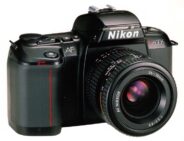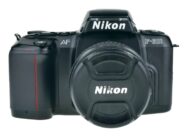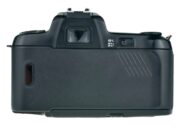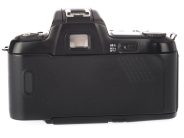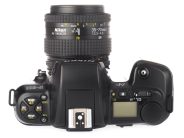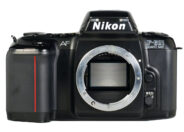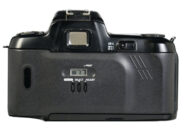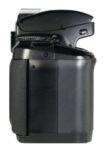Nikon N6006
akaNikon F-601
35mm AF film SLR camera • Discontinued
- Announced:
- · 1990
- Production status:
- ● Discontinued
- Country of design:
- · Japan
- System:
- · Nikon F (1959)
Specification
| Format: | |
| 35mm full frame | |
Film type: | 135 cartridge-loaded film |
| Nikon F [46.5mm] | |
| Shutter: | |
Type: | Focal-plane |
Model: | Electronically controlled |
Speeds: | 30 - 1/2000 + B |
| Exposure: | |
Exposure metering: | Through-the-lens (TTL), open-aperture |
Exposure modes: | Programmed Auto |
| Aperture-priority Auto | |
| Shutter-priority Auto | |
| Manual | |
| Physical characteristics: | |
Weight: | 650g |
Dimensions: | 154.5x100x66.5mm |
Manufacturer description #1
When you're ready to start making the world's greatest pictures, the N6006 is ready for you. With built-in wide-angle flash, motor drive, three light meters, autofocus and an array of other features, the N6006 dares anyone to try new and exciting photographic techniques.
5-SEGMENT MATRIX METERING
The best light meter for action photography, the N6006 uses 5-segment matrix-metering for reliable exposures even in difficult or rapidly changing light conditions. The matrix meter breaks the scene down into 5 segments, evaluates each for brightness and contrast, and provides the correct exposure of the main subject in virtually any lighting situation. In situations where you might be wondering what to do, your N6006 already knows.
SPOT AND CENTER-WEIGHTED METERING
For more controllable situations, or where you want to put more emphasis on a centrally located subject, center-weighted metering concentrates 75% of the exposure on the center of the viewfinder. To concentrate the exposure even further, switch to spot-metering. Now the exposure is based on a 3.5mm-diameter circle in the center of the viewfinder. The spot meter is effective when precise measurement of the subject is required.
BUILT-IN WIDE-ANGLE FLASH
This flash works beautifully with your N6006 light metering systems. Touch the buttons and it pops up, ready for use. This flash offers the widest coverage of any built-in speedlight (covers Nikon lenses down to 28mm). The N6006 flash also packs a wallop, offering a guide number of 43 (with ISO 100 film/feet).
MATRIX-BALANCED FILL-FLASH
Using matrix-metering, the N6006 computer evaluates the scene's available light brightness and contrast and calculates the exposure. It then fires the flash, controlling output for a balanced fIll-flash picture. You'll use this flash for everything from still-life to action photographs, since automatic flash sync speeds range from 1/125 all the way down to 30 full seconds.
FLASH COMPENSATION
Your N6006 will make superb matrix-balanced fill-flash photographs, right out of the box. But if you want to modify the power of the flash, to create brighter or more subtle tones, the N6006 offers flash compensation. Simply dial in your change to the flash power, from +1 to -3 EV.
SLOW SYNC FLASH
When flash pictures are taken at high shutter speeds in dim light, the background may come out dark. For sunsets or night scenes, etc., a better background exposure may be achieved with Programmed or Aperture-Priority auto exposure mode, using slow sync. With slow sync, the flash fires at the beginning of the exposure and shutter speed is controlled between 1/125 sec. and 30 sec: the slowest shutter speed available in normal sync is 1/60 sec.
REAR-CURTAIN FLASH
Using either the built-in speedlight or an accessory Nikon Speedlight, you can also make unusual rear-curtain sync photographs. With this technique, the flash fires at the end of the exposure, rather than at the beginning. Using slow shutter speeds, a stream of motion will appear behind the moving subject.
HIGH SPEED AUTOFOCUS WITH FOCUS TRACKING
The N6006's autofocus system will operate in light as dim as that of one candle (EV-1). Choose Single Autofocus, where focus remains locked until you again press the shutter release, or Continuous Autofocus, where the system focuses and refocuses automatically, as long as the shutter release is slightly depressed. In either mode, if the subject is moving, Focus Tracking takes over and makes any necessary adjustments. Focus Manually using the electronic rangefinder, if you like, or press the Focus Lock Button to create off-center compositions.
FIVE AUTOMATIC EXPOSURE MODES INCLUDING MANUAL
Using the Program Mode (P), your N6006 will automatically set the appropriate aperture and shutter speed for you. By switching to the Auto Multi-Program mode (Pm), you automatically switch the camera to higher shutter speeds, ideal for use with telephoto lenses. Or, choose Shutter Priority (S) to freeze or blur the action. Choose Aperture Priority (A) to create a greater or shallower depth of field. Or, operate the camera on Manual (M), where you choose the aperture and shutter speeds that meet your needs. Use the Auto-Exposure Lock Button to set the exposure on the subject - then recompose any way you like. Flexible Program allows you to modify aperture and shutter speed combinations when using Program Modes.
AUTO EXPOSURE BRACKETING
By simply setting Auto Exposure Bracketing, the N6006 will bracket either 3 or 5 exposures for you automatically. You choose the amount of compensation between each frame in 0.3, 0.7 or 1 EV increments. Produce a range of exposures of the same subject, quickly and easily.
VARIABLE SELF-TIMER
The N6006's self-timer lets you choose a delay of from 2 to 30 seconds. Also take two self-timer shots in a row, automatically.
Manufacturer description #2
With the Nikon N6000 you focus manually and add your own Nikon Speedlight separately. Other features are virtually identical to the N6006 - matrix-metering and center-weighted metering (no spot-meter with N6000), auto-exposure, auto-bracketing, motorized film advance, slow-sync flash, rear-curtain flash, flash compensation, 1/2000 sec. shutter speed, variable self-timer, etc.
Manufacturer description #3
TYPE OF CAMERA: Integral-motor 35mm single-lens reflex
PICTURE FORMAT: 24mm x 36mm (standard 35mm film format)
LENS MOUNT: Nikon F mount
LENS: Nikkor lenses having CPU contacts, AI-S-type Nikkor lenses*, AI-Nikkor lenses* and AI-modified Nikkor lenses* (With limitation)
FOCUS MODES: Autofocus, and manual focus with electronic rangefinder
AUTOFOCUS MODE: Focus-Priority Single autofocus and Focus-Priority Continuous autofocus
AUTOFOCUS DETECTION SYSTEM: TTL phase detection system using Nikon advanced AM200 autofocus module
AUTOFOCUS DETECTION RANGE: Approx. EV minus 1 to EV 19 (at ISO 100)
AUTOFOCUS LOCK: Possible once a stationary subject is in focus in Focus-Priority Single autofocus; Focus-Priority Continuous autofocus, focus can be locked by using AE-L/AF-L lever when AF-L function is set
ELECTRONIC RANGEFINDER: Available in manual focus mode with AF Nikkor and other AI-type Nikkor lenses with a maximum aperture of f/5.6 or faster
EXPOSURE METERING: Three types of exposure metering systems - Matrix metering, Center-Weighted metering and Spot metering
METERING RANGE: EV 0 to EV 19 (at ISO 100 with f/1.4 lens) for Matrix and Center-Weighted metering; EV 4 to EV 19 (at ISO 100) for Spot metering
EXPOSURE METER: Activated by lightly pressing shutter release button; stays on for approx. 8 sec. after lifting finger from button
EXPOSURE MODES: Programmed auto (PM, P), Shutter-Priority auto (S), Aperture-Priority auto (A) and Manual (M) modes
PROGRAMMED AUTO EXPOSURE CONTROL: Both shutter speed and aperture are set automatically; Flexible Program in one EV step increments possible
SHUTTER-PRIORITY AUTO EXPOSURE CONTROL: Aperture automatically selected to match manually set shutter speed
APERTURE-PRIORITY AUTO EXPOSURE CONTROL: Shutter speed automatically selected to match manually selected aperture
MANUAL EXPOSURE CONTROL: Both aperture and shutter speed are set manually
EXPOSURE COMPENSATION: Possible using exposure compensation button within ±5EV range in 1/3EV steps
AUTO EXPOSURE LOCK: Available by sliding the AE lock lever while the meter is on
AUTO EXPOSURE BRACKETING: 3 or 5 frames can be taken of the same subject using a variety of exposures (with compensation degree of 0.3, 0.7 or 1 EV between each frame)
SHUTTER: Electromagnetically controlled vertical-travel focal-plane shutter
SHUTTER RELEASE: Electromagnetic type
SHUTTER SPEEDS: Lithium niobate oscillator-controlled speeds from 1/2000 to 30 sec.; stepless in Programmed auto and Aperture-Priority auto exposure modes; one EV steps in Shutter-Priority auto and Manual exposure modes; Electromagnetically controlled long exposure at B setting
VIEWFINDER: Fixed eyelevel pentaprism high-eyepoint type; 0.75X magnification with 50mm lens at infinity; 92% frame coverage
EYEPOINT: Approx. 18mm
EYEPIECE COVER: Model DK-5 (provided) prevents stray light from entering viewfinder
FOCUSING SCREEN: Fixed Nikon advanced B-type BriteView screen with central focus brackets for autofocus operation
FILM SPEED RANGE: ISO 25 to ISO 5000 for DX-coded film; ISO 6 to ISO 6400 for manual setting
FILM SPEED SETTING: Auto for DX-coded films and manual setting available
SELF-TIMER: Electronically controlled; timer duration can be selected between 2 to 30 sec. in one sec. increments; blinking LED indicates self-timer operation; two-shot self-timer is possible; can cancel at any time
REFLEX MIRROR: Automatic, instant-return type
FLASH SYNC CONTROL: Normal sync, slow sync and rear-curtain sync provided
BUILT-IN TTL FLASH: Guide number: 13 (at ISO 100, 20 deg. C and meters); angle of coverage: 28mm lens or longer; TTL auto flash including automatic balanced Fill-Flash is possible
FLASH SYNCHRONIZATION: In Programmed auto or Aperture-Priority auto shutter operates 1/125 to 1/60 sec. {or 1/(focal length) in use at lens focal length less than 60mm} in normal sync or 1/125 to 30 sec. in slow sync; in Shutter-Priority auto or Manual exposure mode, shutter fires at speed set, and when set from 1/250 to 1/2000 sec., shutter is automatically set to 1/125 sec.
AUTOMATIC BALANCED FILL-FLASH: Possible with built-in TTL flash or Nikon-dedicated Speedlights such as SB-24, SB-23, S8-22, S8-20, SB-18 and SB-16B
MANUAL FLASH LIGHT OUTPUT COMPENSATION: Can be controlled from +1EV to -3EV in 1/3 step increments
FLASH READY-LIGHT: Without flash: Blinks when using flash is recommended (with scene brightness darker than EV10 at ISO 100 or scene brightness of EV10 or higher at ISO 100 where the center portion is darker than other areas by more than 1EV). With flash: Lights up when built-in TTL flash or Nikon dedicated Speedlight is ready to fire or blinks to warn of insufficient light for correct exposure
ACCESSORY SHOE: Standard ISO-type hot-shoe contact; ready-light contact, TTL flash contact, monitor contact
FILM LOADING: Film automatically advances to first frame when shutter release button is depressed once
FILM ADVANCE: In S (Single-frame) shooting mode, film automatically advances one frame when shutter is released; in CH (Continuous High) or CL (Continuous Low) shooting mode, shots are taken as long as shutter release button is depressed; in CH mode, shooting speed is approx. 2.0 fps, and in CL, approx. 1.2 fps
FRAME COUNTER: Additive type; counts back while film is rewinding
FILM REWIND: Automatically rewinds by sliding film rewind lever while pressing film rewind button; approx. 26 sec. per 36-exposure film roll or 19 sec. per 24-exposure film roll; stops automatically when film is rewound
CAMERA BACK: Hinged back; unchangeable
POWER SOURCE: 6V lithium battery pack (Duracell DL-223A/Panasonic CR-P2 or equivalent)
CHECKING BATTERY POWER: Battery power is sufficient if shutter speed and aperture indications appear on the LCD panel and viewfinder by turning camera on or by lightly pressing shutter release button, and remain on for approx. 8 sec. after finger is removed from the button; battery power is insufficient if these indications turn off immediately after finger is removed from the button; if LCD blinks and shutter does not operate, batteries are exhausted or improperly loaded

